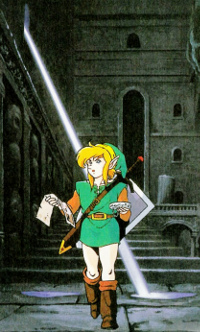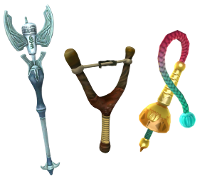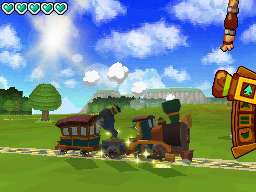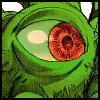5 More Conventions Zelda Wii U Should Rethink
Posted on April 12 2013 by Axle D. Wilder
 When Nintendo announced that their mission for Zelda Wii U was to rethink the conventions of Zelda, I thought it was a bit odd they only listed two such conventions that they wanted to break away from: “Complete dungeons in a certain order” and “Play by yourself”. Granted, they did say that they started to do this with Skyward Sword (but weren’t able to do everything they wanted), so these are probably going to be included with convention changes found in Skyward Sword. That said, I don’t think they’re going to be the only rethought conventions either, or at the very least they shouldn’t be. These are five more conventions I think they should rethink for the next Zelda game!
When Nintendo announced that their mission for Zelda Wii U was to rethink the conventions of Zelda, I thought it was a bit odd they only listed two such conventions that they wanted to break away from: “Complete dungeons in a certain order” and “Play by yourself”. Granted, they did say that they started to do this with Skyward Sword (but weren’t able to do everything they wanted), so these are probably going to be included with convention changes found in Skyward Sword. That said, I don’t think they’re going to be the only rethought conventions either, or at the very least they shouldn’t be. These are five more conventions I think they should rethink for the next Zelda game!
5. Predictable Dungeon Structure
Making it so the dungeons can be completed in different orders is all well and good, but they should also work on the dungeons’ interiors. In nearly every Zelda game, what do you do? I’ll tell you what you do: You enter a dungeon, collect a Dungeon Map and Compass, then you hunt down a dungeon item and use it to defeat the dungeon’s boss… after locating the Big Key, of course. The Zelda games that deviate from this usually still keep up a rigid dungeon structure within the game itself, such as how you also collect the Stone Beaks in the dungeons in Link’s Awakening, or how Skyward Sword condenses the Dungeon Map and Compass into one item, but also has the special boss keys you have to rotate and fit into slots. Regardless of the changes from game to game, every dungeon within a game tends to follow that game’s “dungeon rules”.
 Bleeeeeaaaaaargh! Does it have to be the same every time? In a post I made a couple of weeks ago, I talked about how Sheik’s appearance at Kakariko Village in Ocarina of Time felt more like an interaction between real people than his prior appearances, and made me think of him as an actual character instead of a construct of the game design, and part of that is because it departed from the rigid structure of every previous Sheik scene. Don’t get me wrong; rigid structure is important in many facets of game design — and life, honestly — but it can also make things feel artificial. Until the game departed from the structure, Sheik felt like little more than a game design element designed to allow you to progress, because nearly every scene with him did little more than follow the exact same sequence of conversation and then give you a new song. Nearly every dungeon in the series follows a structure or sequence in the same way, and this makes them feel like exactly that: Structured areas prepared ahead of time.
Bleeeeeaaaaaargh! Does it have to be the same every time? In a post I made a couple of weeks ago, I talked about how Sheik’s appearance at Kakariko Village in Ocarina of Time felt more like an interaction between real people than his prior appearances, and made me think of him as an actual character instead of a construct of the game design, and part of that is because it departed from the rigid structure of every previous Sheik scene. Don’t get me wrong; rigid structure is important in many facets of game design — and life, honestly — but it can also make things feel artificial. Until the game departed from the structure, Sheik felt like little more than a game design element designed to allow you to progress, because nearly every scene with him did little more than follow the exact same sequence of conversation and then give you a new song. Nearly every dungeon in the series follows a structure or sequence in the same way, and this makes them feel like exactly that: Structured areas prepared ahead of time.
This breaks immersion. How well am I really supposed to think of the dungeons as actual places in the world when they appear so well prepared according to a checklist? If I go and explore some caves and ruins in the real world, I’m not going to find means of exploring those “dungeons” in the same way or progress through them the same each time; that would be weird! Deeply weird. Zelda Wii U would do well to shed any semblance of this rigid structure. Certainly it can keep a few recurring elements of dungeon exploration throughout the game, and should, but expanding the structure beyond that for many of them would do a lot to make them feel like believable areas in the world.
I should acknowledge that there are a few examples of this in the series, particularly in Twilight Princess and Skyward Sword. Twilight Princess has you explore Snowpeak Ruins in a very different way than any other dungeon — in this dungeon you collect soup ingredients while searching for the Bedroom Key (Big Key) according to a character’s directions, and unlike the rest of the game, acquire the Compass early so you can locate a buried key. In the Goron Mines, you must piece together the Big Key by meeting with several Goron Elders. Skyward Sword also differs from its own structure with areas like the Sky Keep, and how Ghirahim is never fought with a dungeon item. There are a few other examples in the series as well. All I’m saying is that at least half of a game’s dungeons shouldn’t follow exactly the same rules — perhaps similar rules, but not exactly the same — or else they won’t feel like real places. I haven’t really minded this structure in the past, but I think now’s about time for Nintendo to start rethinking it and do something a bit cooler. A dungeon without a map where you must uncover each room for yourself? One where you acquire the dungeon item before the dungeon or even after completing it? A game with more boss battles not strictly themed around a single item? There’s a lot of cool things they could do.
4. Barely Used Items and Abilities
 This one started a long time ago in the classic games, particularly A Link to the Past, but it’s continued until this day. In A Link to the Past you had items that rarely came in handy, like the Cane of Byrna, and you see it in Twilight Princess and Skyward Sword as well; items like the Dominion Rod or the Whip are barely used at all outside of their respective dungeons. I’m not taking up a beef with items that are useful but that just don’t seem like they’re used that often by players, like Deku Nuts in Ocarina of Time. That’s the player’s fault!
This one started a long time ago in the classic games, particularly A Link to the Past, but it’s continued until this day. In A Link to the Past you had items that rarely came in handy, like the Cane of Byrna, and you see it in Twilight Princess and Skyward Sword as well; items like the Dominion Rod or the Whip are barely used at all outside of their respective dungeons. I’m not taking up a beef with items that are useful but that just don’t seem like they’re used that often by players, like Deku Nuts in Ocarina of Time. That’s the player’s fault!
But I’ve always thought that if an aspect of a game doesn’t really come in handy, it shouldn’t be in the game at all. And if it only comes in handy to a very minimal degree, in most cases it should probably be expanded. Epona isn’t really that useful in Ocarina of Time aside from her coolness factor; you never actually need her at any point in the game barring maybe one or two brief uses in sidequests, because the one gap she’s meant to jump can be crossed with the Longshot, and by the time you get her, you’re already racking up a multitude of warping songs to get around faster than she can go anyway. In The Wind Waker, you only have to sidle across tiny ledges in the Forsaken Fortress and Dragon Roost Cavern, and throughout the rest of the game there either aren’t any opportunities to do it, or they’re actually less effective than just rolling and jumping to the next ledge. Then there are the many examples in recent games where dungeon items stop being very useful outside the dungeon they’re found in, or items that are quickly replaced by infinitely better ones while still staying in your inventory; why would I ever use Twilight Princess’ Slingshot after acquiring its Bow, particularly when you get the latter so early in the game?
This is really just a simple matter of not adding elements and options to the gameplay unless they do something for the player — you know, rocket science here — and when you do add elements that are cool (don’t do this if they are lame), use them more than just a few times; by virtue of the fact that they are cool, you should use them a lot!
3. Overly Familiar and Simplistic Areas
This one’s not actually as big of a deal to me, because I don’t terribly mind retreading the same forest, mountain, and water-themed areas in most Zelda games as long as they have different layouts, atmospheres, and denizens, as they so often do. That said, it could be pretty interesting to expand past them.
Lanayru Desert in Skyward Sword made a pretty big impact among fans for being such a unique area and just generally cool. It’s the first desert of this particular size and importance in any Zelda game, so right off the bat its a more refreshing setting, but its Timeshift Stone mechanic ends up turning it into a very unique concept that is unlike anything we’ve seen before. It manages to feel especially fantastic and interesting, unlike many Zelda locations which tend to still feel like something you might see in the real world.

The real beauty of Lanayru Desert, however, is in the fact that it’s basically an expansion of an existing theme. We have seen deserts before, inside and outside of Zelda. But we haven’t seen one combined with such a localized time travel concept; we haven’t seen a desert that you can temporarily regress into its previous state as a lush landscape. What’s really cool and even hopeful about Lanayru Desert is how, in making it, Nintendo took a very conventional and familiar idea and added something new to it to make it unique.
Bottom line is the Zelda series doesn’t need to ditch its recurring staples, like the forests and mountains, but simply stop being so simplistic and basic about how to approach them. Design them with new ideas in each game! They don’t need to be as drastic as freaking time travel, but giving them some modifications in each game to give them new feels even as they reappear is an awesome idea. This applies as much to specific landmarks like Death Mountain and Lake Hylia as it does to broader area themes like “forest”.
2. Segmented World With Alternate Transportation
Can we please, please, PLEASE stop doing this? Why was this ever such a big thing?!
 Beginning with The Wind Waker, there are now four games in the series designed like this, including the last three Zelda games released. I’ve talked about this in pretty excruciating detail over the years, but man, talk about rigid structure! Does it really feel good, organic, and believable to always explore the game’s world in a weird detached way, where you can only reach new areas by hopping on a totally alternate method of gameplay and riding it through a different overworld that, functionally, is really just warping you to the individual areas which aren’t actually connected at all otherwise? It feels faaaaaaaaaake.
Beginning with The Wind Waker, there are now four games in the series designed like this, including the last three Zelda games released. I’ve talked about this in pretty excruciating detail over the years, but man, talk about rigid structure! Does it really feel good, organic, and believable to always explore the game’s world in a weird detached way, where you can only reach new areas by hopping on a totally alternate method of gameplay and riding it through a different overworld that, functionally, is really just warping you to the individual areas which aren’t actually connected at all otherwise? It feels faaaaaaaaaake.
These “Transportation Overworlds” will always have their defenders, and that’s fine. But let’s be honest here: Zelda is an adventure game, and some of the best adventure games allow you to truly experience the world in all its detail, or at least see the progression between areas as you explore individual locations and locate secrets. Chopping up these areas into detached gameplay spaces that you can only travel between by leaving them entirely breaks immersion by making sure the player doesn’t travel between them directly, while rigidly defining how the player is allowed to approach and experience them. Even if you’re a proponent of this style of transportation — and it can be done well, just in better examples — surely you can agree that, after having four games lately that are based on the idea, it’s probably time for a break? This was never a staple of Zelda until the GameCube, and we’re two entire home consoles past it. Let’s get back to what A Link to the Past or The Minish Cap did; give the world unique areas, but make them connected, parts of a single world, and don’t force the players to jump out of the world just to move around it.
Fast travel options like horse riding and warping are fine, as they give the player the option skip over areas they might have cleared out already and cut down needless travel time. It’s really just this total segmentation of the world that I have a problem with. Including a transportation option as a replacement for fast travel would also be acceptable (and interesting), and originally this is what I thought they were going to do with Skyward Sword: Allow you to explore the land below on its own, while giving you the option to fly over it very quickly and essentially warp around it. So there are still ways to include elements like these without breaking the world up and stunting any real sense of exploration.
1. Musical Instruments and Time Travel
 These too. Why were these ever such a big thing?
These too. Why were these ever such a big thing?
Instruments have been in Zelda since the first game, but only in a limited capacity. In the early days, they were mostly used as warping items, and while they did expand past that in Ocarina of Time, that’s largely what it was there, too. I don’t have a problem with instruments as minor items, but they appear again and again as major items that influence the plot. The Wind Waker from… The Wind Waker, the Spirit Flute from Spirit Tracks, and the Goddess Harp from Skyward Sword. I don’t understand why this has become something so important and recurring.
I’ll admit the instruments aren’t that big a deal. They don’t really hurt anything, and they generally help create some neat moments. It just confuses me why Nintendo decided to, frankly, partially narrow the themes of Zelda down to an instrument. Certainly, its most beloved game used a musical instrument, but that doesn’t mean having one adds anything in particular to the game, and I think it’s kind of silly that Nintendo has since insisted in forcing an instrument into every major title. It’s particularly bad in Twilight Princess, where the music mechanic is really shoehorned in with non-items that are irregularly used like the whistling grass and the wolf howling, or Skyward Sword where the game pretty much departed from the music idea in every way… except departing from the music idea. Skyward Sword centered around the sword as its titular item. The Goddess Sword featured prominently in the gameplay and story; almost the entire game centered around it and other elements, like the separation of surface and sky. Why, then, was a musical instrument shoved back in? The harp has effectively no real purpose in Skyward Sword. It’s rather clear that, like with Twilight Princess, they put it in just because they felt it should be there. Let’s get out of that mentality, and only use instruments as major items when the game is built around them and let us have some different central themes and mechanics in the meantime! I don’t mind having detailed musical elements like those in Spirit Tracks, where it was an actual aspect of gameplay that you could succeed or fail at, but I also am a little burnt out on the them overall. Just give it a break, Nintendo, and when you do revisit it, do something cool with it.
And time travel? Look, having time travel in Ocarina of Time and Majora’s Mask was awesome. It was neat in Oracle of Ages. It was a little random and brief but sorta cool in Twilight Princess. It was confusing and annoying in Phantom Hourglass. And it was pointless in Skyward Sword… barring the Timeshift Stone stuff, which was pretty cool as I said earlier.
This theme, more so than the instruments even come close to, has been totally exhausted. Time travel is cool when it’s done well, but I don’t see why it’s become such a staple of the franchise. It felt like a natural part of the gameplay and story in Ocarina of Time and Oracle of Ages, and functioned as an acceptable cameo when you visited the Temple of Time in Twilight Princess. But the time-stopping power in Phantom Hourglass was just weird and didn’t make sense at all with its user being the Spirit of Courage, and including it as a major plot point again in Skyward Sword just seems pointless; I don’t really see what having Zelda and Impa (and later Ghirahim and Link) travel back in time to an earlier era really added to the plot. A little extra temporal epicness? Yeah I guess. A lot more convolution in the plot? Definitely. And it just seems tired at this point; if it’s continuously added to games it doesn’t need to appear in, how are we supposed to take it that seriously each time we return to some past era to stop some random old evil guy? Even if the theme is cool, any theme stops being cool if you overuse it. I should not be able to say “I am getting bored with traveling to another era to stop an evil demon from destroying the world.” but that’s exactly what I’m saying! This concept should be cool, not exhausting.

Nintendo, give these two themes a break so that the next time they come in handy, they can be refreshing and awesome again. And let’s rethink the other stuff on the list too, okay? I’m not saying all of these entries were bad in every game they appeared; I’ve enjoyed every Zelda game that I’ve played. But if Nintendo’s mission with the new game is already to rethink tired conventions that might be outdated, overused, or just hold back the fun, well then I think these suggestions qualify and should be removed or reworked.
If you guys have anything you would add to this list, or any thoughts about my additions, tell me in the comments!




